 Author: Eiji OKUBO Sales Network: Amazon.com / Amazon.co.jp |
| Written by Eiji OKUBO, Printed books and e-books Heritage of Minoan and Mycenaean civilizations Detailed data on Ruins and Excavated items |
| The Minoan Palace of Knossos (v. 1) |
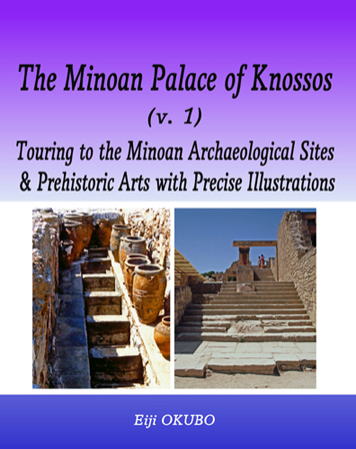 |
| subtitle: Touring to the Minoan Sites and Prehistoric Arts language: English format: Paperback printing paper: Non-glossy high-quality paper printing ink: High-saturation premium ink size: 8in.x10in. (203mm x 254mm) 419 pages sales: Amazon Network / Amazon.com / Amazon.co.uk |
| Summary: This book is 8in. x 10in. (203mm x 254mm) version, 410 pages, an explanatory book on the Prehistoric Minoan civilization. It provides a thorough and detailed explanation of the Knossos Palace ruins on Crete, the largest center of the Minoan civilization. The book provides a detailed explanation of all the ruins in the Knossos Palace, including many of unpublished interior photos of the palace, which are currently the restricted area for tourists, and drawings of the ruins. At the same time, the book is including the Precise illustrations of most of the important artifacts excavated in the palace and related ruins, and many photographs. The excavated items are selected from the countless exhibits at the Heraklion Archaeological Museum, which boasts one of the largest displays of Minoan civilization artifacts, as well as at other museums on the island of Crete, and at the National Archaeological Museum of Athens on the Greek mainland. By exploring and comparing artistic motifs, trends, genealogy, and so on in the coordinated manner, the Minoan civilization, known as the "Europe's first civilization," the book will be elucidated in a comprehensive, three-dimensional, and easy-to-understand manner. Book structure: The book consists of volumes 1 and 2, both were published simultaneously. Volume 1 I Overview of Minoan Civilization & Knossos Palace II Around Palace, West Court, South Wing I II Central Court & Throne Room Complex IV Palace Royal Sanctuary in West Wing V West Storerooms & Linear B Clay Tablet VI Fresco “Goddess Parisienne” Volume 2 VII King’s Room Complex & Shrine of Double Axe VIII Queen’s Room Complex IX Fresco “Bull leaping” X North Wing & East Wing, Fresco “Ladies in Blue” XI Prehistoric Sites around Knossos Palace |
| Sample Page:(excerpt) ---------- 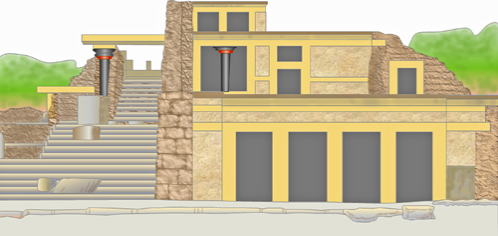 Site: Throne Room Complex, West Wing, Minoan Knossos Palace a) left=Central Great Staircase b) right=Waiting Room & Throne Room, restored wall c) front=Central Court d) 2nd floor=restored Room of Fresco e) 3rd floor=restored Era: MMIIIA-LMIIIA1, 1625-1375 BC Local: Central North, Crete Drawing: Eiji OKUBO GPS: 35°17'53''N 25°09'47''E / ALT 95m III-3-03 Throne Room, King’s Office Room Contrary to expectations, the Minoan King's Office Room, the Throne Room, located at the back (west side) of the Waiting Room on the first floor of the West Wing, is not particularly large.  Site: Throne Room, West Wing, Knossos Palace (Currently Restricted Area) a) remains of Minoan civilization=fire-marked gypsum stone throne, bench, floor b) Throne=oldest throne in Mediterranean region c) number of people who can sit on stone benches, north-west-south sides=16 people d) North benches on either side of Throne=highest-ranking officials of palace were seated e) griffin and papyrus fresco wall=restored by Sir Arthur John Evans and Émile Gilliéron Era: MMIIIA-LMIIIA1, 1625-1375 BC Local: Central North, Crete Photo: 1982 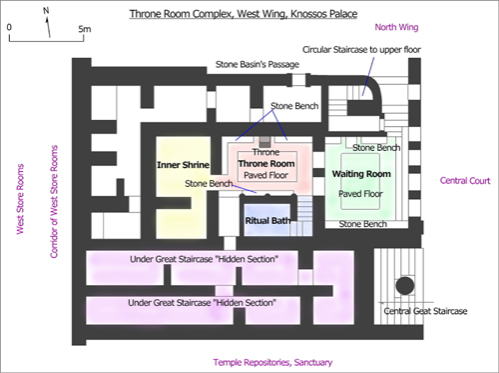 Site: Plan of Throne Room Complex, West Wing, Knossos Palace Era: MMIIIA-LMIIIA1, 1625-1375 BC Local: Central North, Crete Drawing: Eiji OKUBO In the Throne Room, which is paved with gypsum stone, three gypsum long benches are installed along the north, west, and south walls, 3/4 of the way around the room, except for the east side (Waiting Room side), and on the north side is a stone throne that was actually sat on by successive Minoan kings more than 3,400 years ago, facing south. During Evans' excavation mission 125 years ago, the ground surface at the time of excavation near the Throne Room was about 50cm above the top of the backrest of the throne. The stone benches, which were charred during the final collapse of the Knossos Palace due to the great fire around 1375 BC, remain underground as it was in the Minoan period, and the walls of the room are said to have been in the collapsed state. In the Throne Room, the fresco decorations on the west and north sides, which are decorated in scarlet and madder colors and feature imaginary animals griffins facing each other on either side of the throne, and papyrus, were restored onto the concrete walls in 1913 and 1930 by Sir Arthur John Evans and Swiss archaeological artist Émile Gilliéron. While the floor space is by no means large, the overall image of the Throne Room gives the sense of the mystique and majesty of power that it possessed as the King's Office Room for the supreme ruler of the Minoan Kingdom, the most prosperous kingdom in the prehistoric eastern Mediterranean region. Those who have actually seen the Throne Room will be able to clearly see the clear role of each room when comparing the "King's Office Room" in the West Wing, which exudes the sense of dignity and awe, with the relaxing King's Living Room, so-called the "Double Axe Room, in the Royal Family's Private section in the East Wing.  Site: Double Axe Room (King’s Living Room), East Wing, Knossos Palace (Currently Restricted Area) a) Minoan Fresco of running spiral pattern on New Palace Era wall b) wall & fresco=preservation of state during excavation c) wooden Throne (replica) Era: MMIIIA-LMIIIA1, 1625-1375 BC Local: Central North, Crete Photo: 1982 III-2-01 Clay Seal Imprints from Central Great Staircase 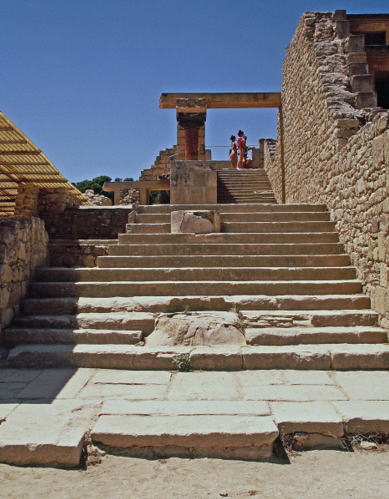 Site: Central Great Staircase, West Wing, Knossos Palace Situation: Largest Staircase in Knossos Palace connecting 2nd and 3rd floors from Central Court Era: MMIIIA-LMIIIA1, 1625-1375 BC Local: Central North, Crete Photo: 1994 The wide, partially restored Central Great Staircase remains in the exact center of the West Wing facing the Central Court of the Knossos Palace ruins. The Central Great Staircase, which leads to the upper floors (second to third floors) of the West Wing, is the largest staircase in Knossos Palace, and its orderly structure and size, as well as its location with the Throne Room Complex to the north and the Palace Sanctuary Area to the south, demonstrate the importance of the Great Staircase within the palace. During Evans' excavation, several clay seal’s imprints were found on the landing of the Central Great Staircase at the Knossos Palace ruins. There is no reason for clay imprints to be on the Great Staircase of the palace, so it can be assumed that they fell from the rooms of palace administrators on the upper floors (2nd to 3rd floors) of the West Wing when the Knossos Palace finally collapsed around 1375 BC.  Site: Central Great Staircase, West Wing, Knossos Palace Shape & Decoration: Clay seal Imprint, six goats or mouflons sitting quietly stamped with hard stone seal? Era: LMIIIA1, ca. 1375 BC Museum: HAM, inv. No. 231 / L24mm Local: Central North, Crete Drawing: Eiji OKUBO Although partially missing, one of the clay imprints is 24mm long and 23mm wide, and has a nearly circular surface with a flowered papyrus stem as the central horizontal line. On the top surface, three docile-looking segmented-horned goats (or mouflons, a species of sheep native to the Mediterranean region and Central Asia) are facing in the same direction, and on the bottom surface, three more are sitting together facing in the opposite direction to the top surface. This clay seal imprint, with its minute and detailed expression, is assumed to have been stamped with a hard stone seal. There is no tense scene of a ferocious lion attacking a bull, nor any divine elements such as carvings of goddesses, and this clay imprint shows the very ordinary, calm and peaceful atmosphere of the Minoan period. The seal's owner is a kind and caring person who held a responsible administrative position in the palace, and who sealed wooden storage boxes containing important items in the palace administrator's room on the upper floors around 1375 BC, about several months or just before the final collapse of the Knossos Palace. It can be determined that another clay imprint found at the same time on the landing of the Central Great Staircase also collapsed from the upper floors (2nd to 3rd floors) around 1375 BC when the palace collapsed. This clay seal imprint depicted the suckling of a cow and her calf, which is presumably imprinted with a 17mm nearly circular, lens-shaped steatite bead seal. The six sitting goats and the cow sucking scene both have in common the fact that they depict the extremely natural poses of familiar animals for Minoan people. The original seals used for the stamp have not been found, it is possible that the owners of these seals, the palace staff who worked on the upper floors (2nd to 3rd floors), were all honest and gentle national civil servants who lived in the city center, called the "ko-no-so" of Knossos. Moreover, there is no doubt that the owners of the seals were trusted individuals of considerable rank who were responsible for making clay seals to manage important items in the palace. 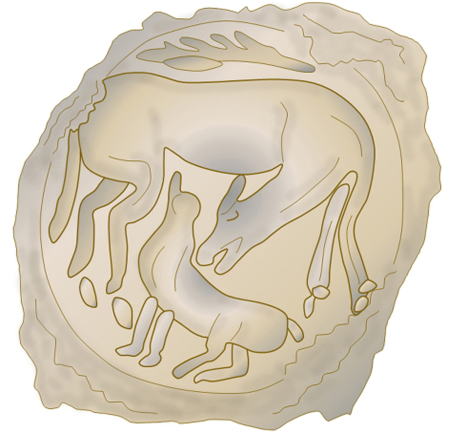 Site: Central Great Staircase, West Wing, Knossos Palace Shape & Decoration: Clay seal Imprint, mother cow suckling her calf reminiscent of a kind seal owner Era: LMIIIA1, ca. 1375 BC Museum: HAM, inv. No. 221 / L17mm Local: Central North, Crete Drawing: Eiji OKUBO IV-4 Temple Repositories IV-4-01 Palace’s Sacred Treasury, Temple Repositories Located to the north of the Sanctuary's Waiting Room with Stone-bench, if we enter from the left door of the stone bench at the northwest end of the Waiting Room, there are two small rooms paved with gypsum stone. This is the "Sacred Treasury" area of the Knossos Palace, where countless religious items and jewelry, including beautiful rhytons that are worthy of symbolizing the Minoan civilization, were stored. 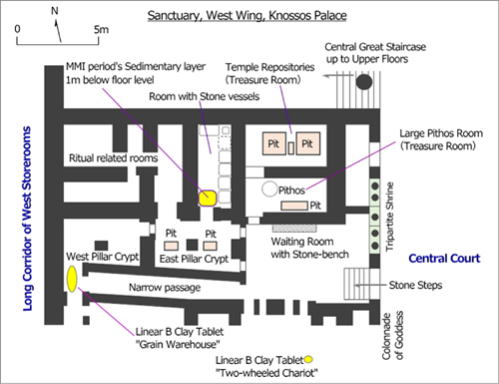 Site: Palace Sanctuary Area, West Wing, Knossos Palace Situation: Plan of Palace Sanctuary Area Era: MMIIIA-LMIIIA1, 1625-1375 BC Local: Central North, Crete Drawing: Eiji OKUBO IV-4-02 Structure of Temple Repositories  Site: Temple Repositories, Sanctuary Area, West Wing, Knossos Palace (Currently Restricted Area) a) box-shaped structure made of gypsum stone slabs b) two large & one small underground storage pits for palace treasures 1) back side=deep large storage pit on west side 2) middle=later shallow small storage pit 3) front=deep large storage pit on east side Era: MMIIIA-LMIIIA1, 1625-1375 BC Local: Central North, Crete Photo: 1982 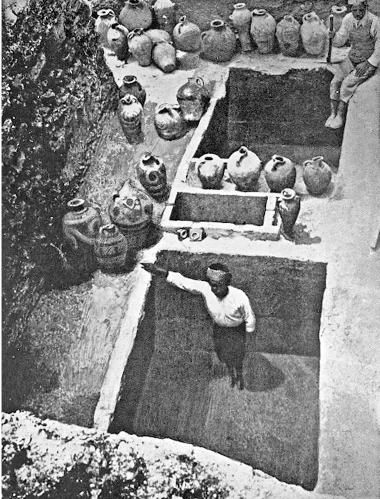 Site: Temple Repositories, Sanctuary Area, West Wing, Knossos Palace Situation: Temple Repositories after immediately excavation & excavated vessels Era: MMIIIA-LMIIIA1, 1625-1375 BC Re. information: Papers, Sir Arthur John Evans “The PALACE of MINOS at KNOSSOS v. I” (1921) Local: Central North, Crete In the prehistoric Minoan civilization, the King was worshipped as a god, and the palace where the king lived was the same as the "temple" where the god lived. For this reason, excavator Evans and other archaeological researchers have called the "Palace Treasury" the "Temple Repositories." The back room located to the north of the Waiting Room with Stone-bench is the storage room for the Knossos Palace's jewelry, and is the place called the Temple Repositories by researchers. The Temple Repositories have two large, deep, square underground storage pits, located a short distance apart to the east and west. The walls of these pits are made of thick gypsum stone slabs stacked in four layers, combined with a bottom also paved with gypsum slabs, forming a sturdy "stone box" each.  Site: Temple Repositories, Sanctuary Area, West Wing, Knossos Palace Three Storage Pits’ structure diagram (unit cm) Era: MMIIIA-LMIIIA1, 1625-1375 BC Local: Central North, Crete Drawing: Eiji OKUBO IV-4-04 Faience Rhyton, “Snake Goddess” Three faience Snake Goddess statues of the same production style, including one missing its upper body, were excavated from the Temple Repositories in the Sanctuary Area. Strictly speaking, they were found in the large storage pit on the east side. Some researchers have determined that the excavated faience figures represent the "mother and daughter goddesses." Like the Double Axe, the Snake Goddess was absolutely worshipped by the Minoan people and was one of the highest symbols of worship in the Minoan civilization. The 295mm tall statue of the "Daughter Goddess" holds a snake in each hand and has a slender figure with her arms spread upwards. Her ample breasts are completely visible through her tight, corset-like outfit. Above the Daughter Goddess's head stands a leopard, lioness, or other animal of the feline family. In the Minoan civilization, along with the griffin, the feline lioness was believed to be a sacred animal that protected the goddess. There is also the large goddess statue, said to be the "Mother Goddess," 342 mm tall with its arms lowered somewhat widely, with snakes wrapped around both arms. Since Minoan times, snakes have been messengers of the gods, and their connection with the goddess has been particularly emphasized. The faience Snake Goddess statue can be said to be a "Minoan masterpiece art," from the Middle Minoan civilization MMIIB to MMIIIA periods around 1625 BC, when the Old Palace Era ended and the prosperous "New Palace Era with dancing Flowers" began, based on its production techniques and the meaning of its expression. Also, some researchers, noting that the Snake Goddesses were discovered in the Temple Repositories during the Evans excavation mission in 1903, sometimes refer to this Palace Sanctuary Area in the West Wing as the "Sanctuary of Snake Goddess."  Site: Temple Repositories, West Wing, Knossos Palace Shape & Decoration: Faience Rhyton, two “Snake Goddesses” Era: MMIIIA, ca. 1625 BC Museum: HAM a) left statue=Mother Goddess, inv. No. 63 / H342mm b) right statue=Daughter Goddess, inv. No. 65 / H295mm Local: Central North, Crete Photo: 1994 IV-4-08 Clay Seal Imprint "Mother Goddess" from Temple Repositories At the Temple Repositories at the Knossos Palace, would have made use of underground storage pits as well as undoubtedly wooden chests, which held particularly important religious jewelry. Multiple clay seal imprints have been found to indicate the sealing of wooden boxes used to store more important objects. Particularly prominent seal motifs include the "Goddess with Lion," "Lion and Tamer," and "Bull leaping." At least eight clay imprints, which named the "Mother Goddess" by researchers for their goddess motif, have been found in the Temple Repositories. Clay seal imprints are made when raw clay on which a stamp is made is burned in an accidental flame, such as a building fire. The clay imprints, the "Mother Goddess," that have been found are in the tattered state each with large and small defects, but the original seal, probably a gold signet ring, on which the imprint was made is oval in shape measuring 29mm long and 19mm wide, and engraved with an Epiphany expression that includes divine elements. 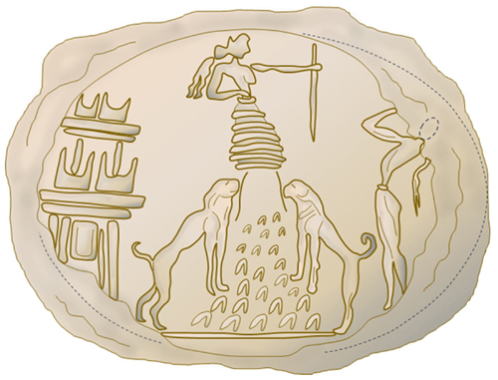 Site: Temple Repositories, West Wing, Knossos Palace Shape & Decoration: Clay Seal Imprint, so-called “Mother Goddess” Epiphany: sanctuary with bull-horn U-shaped objects, goddess with lions, youth Era: clay imprint= LMIIIA1, ca. 1375 BC stamp= probably by gold signet ring, ca. 1400 BC Museum: HAM, inv. No. 141-166-168 / L29mm Local: Central North, Crete Drawing: Eiji OKUBO On the seal imprint, a Minoan goddess in a thick skirt stands on the central hill, guarded by two lions and holding up a scepter, a symbol of authority. On the left is a magnificent shrine or temple decorated with several bull-head U-shaped objects, while on the right (somewhat obscured by missing parts) a young Minoan man with long hair pays homage to the goddess. The clay seal imprint dates to the final collapse of the Knossos Palace, during the Late Minoan LMIIIA1 period, around 1375 BC, but the gold signet ring that imprinted it on was certainly made earlier, making a date of around 1400 BC more plausible. The multiple excavated clay seal imprints of the "Mother Goddess" suggest that treasures used in some ritual or ceremony, such as the "Great Spring Festival" in which seeds are sowed to pray for a good harvest, were placed in wooden boxes and sealed with raw clay by the high priest or palace staff with a gold signet ring, who was responsible for their care, around 1375 BC, a week to a month before the great fire or more little earlier that caused the final collapse of the Knossos Palace. The raw clay lumps with the stamp were burned in the intense flames of the palace great fire and hardened like pottery, then which have remained as the clay seal imprints in the Temple Repositories for more than 3,400 years after the collapse of the palace. Various seals and clay seal imprints featuring the lions, a symbol of power, have been excavated from many Minoan ruins. The 21mm long clay seal imprint of the "Lion and Tamer" excavated from the Temple Repositories shows a docile-looking lion standing beside a lion tamer wearing a feathered tricorn hat or helmet and holding a long stick. The clay seal imprint dates to the Late Minoan LMIIIA1 period, around 1375 BC, when the Knossos Palace finally collapsed, but the seal must have been made earlier. Based on the engraving technique and the popularity of the motif, researchers have determined that the seal was made more than 100 years earlier, around 1500 BC. 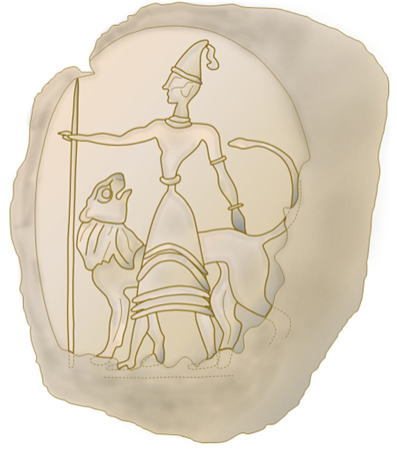 Site: Temple Repositories, West Wing, Knossos Palace Shape & Decoration: Clay Seal Imprint, obedient lion & majestic tamer Era: LMIIIA1, ca. 1375 BC Museum: HAM, inv. No. 383 / W21mm Local: Central North, Crete Drawing: Eiji OKUBO Related: Mycenaean Stone Seal, “Lion & Tamer” motif  Site: Chamber Tomb 8, Lower Town, Mycenae Shape & Decoration: almond-shaped Carnelian Seal gold granulation decorated, obedient lion and tamer Era: LHI-LHII, 1550-1400 BC Museum: NFAM, inv. No. 19375 / W27mm Local: Argolis, Peloponnese Drawing: Eiji OKUBO V-2-05 Minoan Palace style Pithos Jar from West Storerooms 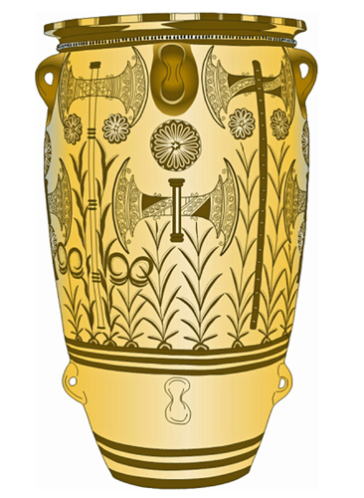 Site: West Storerooms, Room 11-13, West Wing, Knossos Palace Shape & Decoration: Palace style, Large Pithos vessel, “limited edition” for Knossos Palace reed clump of Floral design, double axe and rosette patterns Era: LMII, 1450-1400 BC Museum: HAM, inv. No. 7757 / H1,345mm Local: Central North, Crete Drawing: Eiji OKUBO During the LMIB period of the Late Minoan civilization, around 1450 BC, three Minoan Palaces and countless local mansions and towns on Crete were completely destroyed one after another by the militant Mycenaean invaders from mainland Greece. For about 75 years, until the Knossos Palace finally collapsed in a huge fire around 1375 BC, the skilled craftsmen of the pottery workshops in the East Wing under the rule of the occupying Mycenaeans, established a beautiful pottery style worthy of symbolizing Minoan civilization, which was no exaggeration to say that the “last flower of culture” of the New Palace Era. It was Palace style Ware, which called the most beautiful pottery in the Eastern Mediterranean region at the time and was the “limited edition” for Knossos Palace. The Palace style Ware was a special pottery which developed and improved at the Palace of Knossos, which was after the Mycenaean invasion of Crete around 1450 BC. For this reason, the Palace style Ware have uncovered virtually only from the Knossos Palace ruins, residences adjacent to the palace, and royal cemeteries and tombs scattered a short distance away. In Sir Arthur John Evans' excavations, a large pithos jar with a height of 1,345mm which can be emphasized as the best work of Palace style pottery, from the Rooms 11 to 13 of the West Storerooms, the West Wing of the Knossos Palace. Although it was in a broken state at the time of excavation, but it was concluded that the pithos jar collapsed during the final collapse of the Palace of Knossos, around 1375 BC, from the sacred Northwest Sanctuary Hall, which undoubtedly existed on the upper floor of the West Wing. This large Palace style pithos jar is for decorative purposes. The pattern is basically a Floral design that gives a gentle impression, but the double axe and large rosette, which were the highest worship symbols of Minoan civilization, are expressed majestically in the wide body space. Many works of Palace style ware, a lineage of the Mycenaean civilization on mainland Greece, have been unearthed at Minoan and Mycenaean sites, including beautiful amphora shaped vessels and jugs. However, if it limits to the content of the design among the Palace style pottery which has been unearthed on Crete so far, we can confirm that is not a simple drawing of eight double axes. All patterns of this large ornamental pithos jar, which is accurately depicted with very delicate lines, so that can say to be emphasized as honoring the ruler of Knossos Palace in the highest degree of formality. Therefore, in Minoan pottery, there is no other high-quality art motif that symbolizes reverence than this one. There is no doubt that this large pithos jar was the perfect decoration for the final stage of the Palace of Knossos, and most suitable for decorating the magnificent sacred Northwest Sanctuary Hall on the second floor of the West Wing. The pithos jar was produced in the latter half of the New Palace Era, the Late Minoan civilization LMII period, 1450 to 1400 BC. Related: West Wing, Knossos Palace  Site: Plan of Upper Floor, West Wing, Knossos Palace West Court, West Pouch, South Entrance, Central Court=ground level Era: MMIIIA-LMIIIA1, 1625-1375 BC Re. information: Papers, Sir Arthur John Evans, “The PALACE of MINOS at KNOSSOS v. II” (1928) Local: Central North, Crete Drawing: Eiji OKUBO GPS: 35°17’53’’N 25°09’47’’E / ALT 95m V-1-01 Location of West Storerooms 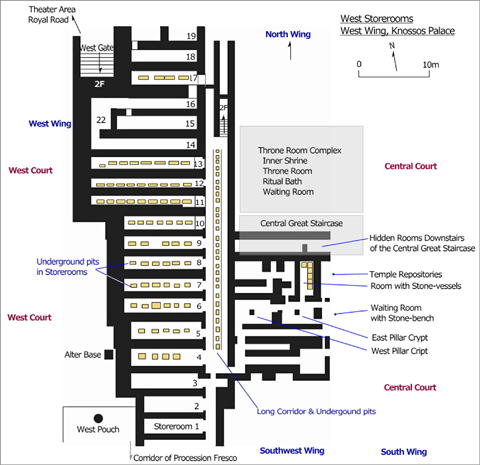 Site: Plan of West Storerooms, West Wing, Knossos Palace Era: MMIIIA-LMIIIA1, 1625-1375 BC Local: Central North, Crete Drawing: Eiji OKUBO V-3-02 Scale & Structure of Long Corridor of West Storerooms The Long Corridor of the West Storerooms in the West Wing is about 3.5m wide from east to west, and has a total length of about 65m from north to south, including the "Southern access route" from the Sanctuary Area and the "Northern access route" from the Throne Room Complex. The walls are completely covered with carefully processed milky white gypsum stone slabs and plaster, and the floor is also paved with gypsum stone. In the Minoan period, this long corridor was not a "simple passageway” of the dimly lit storerooms, but the strikingly beautiful milky white corridor made entirely of gypsum stone that gives an impression clean and softness. In the Minoan palace system, not only the Palace of Knossos, but all other palaces, such as the Malia Palace, had the West Storerooms each in the West Wing, and these storerooms were important sections in charge of the "economy and finances" that were directly managed by each palace. In particular, the West Storerooms of the Palace of Knossos, the center of civilization, were in a very "special location" where only people of special status connected to the Sanctuary and Throne Room Complex in the West Wing were allowed to enter, and could only be accessed via two limited access routes, the "Southern" and "Northern." Unlike the halls and noble rooms located on the upper floors of the West Wing, the Storerooms and its Long Corridor in the West Wing were not decorated with frescoes. However, it is hard to imagine from the current dilapidated ruins that in the Minoan civilization they were aesthetic spots with orderly functional beauty hidden from the eyes of ordinary people. Naturally, here is also now designated as the Restricted Area for tourists.  Site: Long Corridor of West Storerooms, West Wing, Knossos Palace (Currently Restricted Area) a) view from Entrance of Storeroom 4 to Room 16 on Long Corridor b) center of corridor floor=total 27 underground storage pits (protective board cover) c) remaining some pithoi from excavation Era: MMIIIA-LMIIIA1, 1625-1375 BC Local: Central North, Crete Photo: 1994 ---------- |